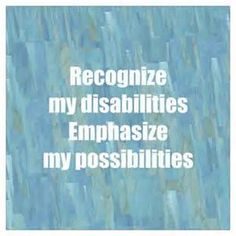The most recent focus on in Society and Lifestyles on inclusion and equality has been disability. We used this as an example to allow us to specifically think about certain types of inequality and exclusion in society. Disability is just one of the many named characteristics which are protected against discrimination by the Equality Act, 2010. However, this allowed us to think in depth about Allport’s Scale of Prejudice and Discrimination using clear examples. Upon reflection of my own experiences witnessing and learning about real-life examples of antilocution, avoidance, discrimination, physical abuse and extermination, I considered that as a person of privilege, it is very difficult, if not impossible, to truly understand how people of the characteristics stated in the Equality Act, 2010 feel and deal with day to day tasks which I often take for granted as being easy.
I was then lead to consider the question: Does disability come from the impairments themselves or from the physical and social environment? I would have to argue the latter. It is very often not the impairment which prevents people from going about every day activities, but it is the restrictions caused by the environment which has been physically and socially built up to suit the majority. If we take example from John Rawls’ belief that in order to achieve equality as fairness, we must look to the least advantaged people first and consider that which would suit them. It is only by doing this that we will begin to see a shift towards a world which accommodates for everyone equally and as integrated.
In a TED talk filmed in October 2009, Aimee Mullens discussed her beliefs about adversity. She believes that adversity itself is not the problem – it is a challenge but it is one which must be looked at from a positive and pro-active point of view. Diversity is everywhere! It always has been and we are developing new ways in which people who are disabled can function most freely. However, it is the attitudes of society and the old fashioned building methods which are behind in the times. It is these two factors which are preventing many people with disabilities from seeing whatever impairment they may have as a part of them which makes them different – not less valuable. It is these which are segregating the advantaged from the disadvantaged.
As I make that statement it brings me to wonder, how can we distinguish between someone who is advantaged and someone who is not? My personal definition of advantage would be something which makes a person a step ahead of someone else. In this day and age should we really be considering people who are different as people who are disadvantaged? The mind-set of society must change as we cannot continue to impose this kind of negativity towards people who may look, act or feel differently to the majority. Aimee Mullens also discusses the idea of normality. It is society which creates this vision of a normal person and it is society which puts pressure on people to be no different to normal. Whether that be a child who is particularly clever at school; someone who chooses to die their hair purple; someone who doesn’t have much money; someone who lives in a different place to you; someone who plays a certain sport; or someone who hates sport and loves to read! The list could go on forvever until the characteristics one must have to be normal create a completely unrealistic view of a person who could not exist! We all have our qualities and our flaws, our likes and our dislikes, our circumstances and our lifestyles. We are all different and there is no true “normal”. Since normal can never exist, we are all competing in an endless cycle against those who are particularly different from us.
In our world of today, we must prevent people who have disabilities from being disadvantaged in any way. It is this line between advantage and disadvantage which creates two groups of majority and minority and which prevents either group from truly understanding the intentions or feelings of the other. As Nancy Fraser believes, it is our advantages which blind us from appreciating the contribution of minority groups. Therefore, the idea of Universal Design, if put in to practice from now on when designing new buildings, we should be able to see a more equal society. Not only allowing for equality as fairness but by influencing attitudes about disabilities. We are all so heavily influenced by society that if it was physically built with disabled and able bodied people considered as one, the line between the two would hopefully fade. This would hopefully lead to less discrimination and a more modern outlook on the possibilities disabled people have.
It is therefore fair to conclude that as a teacher I shall always consider those who are least advantaged in the class room before making sure that the classroom environment suits every child. I also see the great importance in educating children, as emphasised by Nancy Fraser, about minority groups and ensuring that every child’s needs are catered for in an equal, fair and inclusive way.
From learning about this today I found myself faced with many questions which I previously had not considered. Some of which I have discussed above and some of which I shall take away with me and look into further before I conclude my answers. One thing which really stuck with me from watching the Aimee Mullens TED talk was her quote “The exact meaning of the word ‘educate’ comes from the root word ‘educe’. It means to bring forth what is within, to bring out potential.” We must, as educators, students and members of the community, do our very best to bring out the very best in every person and provide them with the support to strive.
